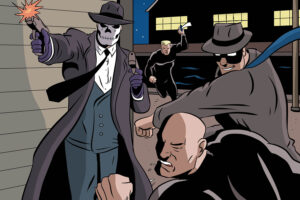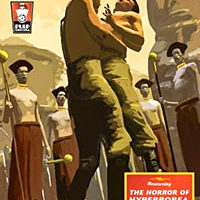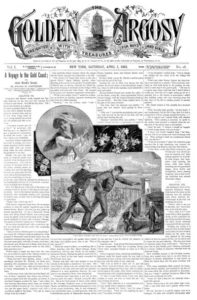
The start of pulp magazines is traced back to The Argosy (1888-1979), started by Frank A. Munsey (1854-1925). He had previously launched the publication as a children’s fiction weekly called the Golden Argosy in 1882 in a newspaper format, but it wasn’t successful. So he relaunched it as a monthly in the same format in 1888, eventually going all fiction and using pulp paper in magazine size to keep costs low in late 1896. This is considered the start of the pulp magazine period. It would go to weekly in 1917. At the time, the main source for inexpensive fiction was the dime novels, which would be replaced between about 1900 to 1915 by the pulp magazines.
As an all-fiction magazine, Argosy published all sorts of fiction: adventure, historical, romance, fantasy, science fiction, western, etc. Focused fiction magazines came later. Like many weeklies, it would publish serialized stories to keep readers coming back. When one serial ended, another started, and there would be another still running, with the rest of the issue filled out with shorter fiction.
I’m not aware of any books or studies focused solely on examining Argosy, but it’s well covered in the Blood ‘n’ Thunder Guide to Pulps and the fanzine Pulpdom has also run information on Argosy and its authors.
Mergers
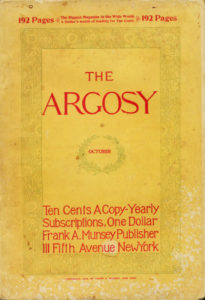
Over the years a few other magazines merged with Argosy, causing some name changes. In 1919, the Railroad Men’s Magazine merged with it and so for the next few month the magazine was Argosy + Railroad’s Men Magazine. Railroad Men’s Magazine had been started in 1905 and is considered the first specialized pulp magazine, tho magazines focused on a particular genre came later.
Another Munsey magazine was Cavalier, which started in 1912 as the first weekly pulp and a spin out of The Scrap Book (which later merged into it). It lasted till 1914 when it merged with All-Story, which had started in 1905. With the merger All-Story became weekly and was re-titled for a year as All-Story Cavalier Weekly. In 1920 All-Story merged with Argosy so from 1920-29 it was Argosy All-Story Weekly.
A strange merger/split occurred in 1929, when Munsey’s Magazine merged with Argosy All-Story, at which point Argosy continued as just Argosy Weekly and All-Story was spun out as as a bi-weekly focused on romance fiction, even re-titling to All-Story Love.
Argosy continued to be weekly through 1941. It’s heyday was the teens, ’20s, and ’30s. It published a great deal of excellent pulp fiction from a variety of authors. It was almost a who’s who of pulp fictioneers: Edgar Rice Burroughs, Johnston McCulley, C.S. Forester, Theodore Roscoe, L. Patrick Greene, George F. Worts, H. Bedford-Jones, Borden Chase, Lester Dent, Cornell Woolrich, Norbert Davis, Fred MacIsaac, Max Brand, Clarence E. Mulford, Walt Coburn, Charles Alden Seltzer, Tom Curry, Ellis Parker Butler, Hugh Pendexter, Robert E. Howard, Gordon MacCreagh, Harry Stephen Keeler, Upton Sinclair, A. Merritt, and many more.
After 1941, it went downhill as a pulp magazine, about the time Munsey’s company was purchased by Popular Publications (in 1942). First it went from biweekly to monthly. It soon started to publish non-fiction, and even went to slick paper. By 1943, it became a “men’s adventure magazine.” It would continue to be published until 1979, but was merely a ghost of its former self, however even during this period, at least in the 40s and 50s, it put out some good fiction. Some refer to it as a “semi porn” men’s mag toward the end. For some reason the last four issues in 1979 were from a different publisher with a different focus, but using the same logo.
Revivals
There were a few attempts at reviving the name and heritage of Argosy. One revival was in the early ’90s. It lasted six issues over about five years (one issue was more an “ash can” edition). I think I have two or three of the issues, the ones with Steranko covers. One of these reprinted Philip Wylie‘s “The Savage Gentleman” as a cover feature, though the story was serialized from the prior issue.
Another attempt in 2004 as a literary magazine produced three issues, so fancy that each issue was two volumes in a slipcase! Pretty far away from the days of pulp fiction.
Today
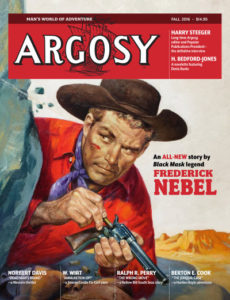
Currently the name lives on today through Altus Press, one of the premier (if not the premier) reprinters of pulp fiction. As they now have the rights, through Steeger Properties, to most of the works from Popular Publications and Munsey (since Popular bought them out), they have been using these rights in a few ways.
One has been the series of books under “The Argosy Library” name. These reprint works from a variety of the Munsey magazines: stand-alone novels, collections of short stories, serials of various sorts. They have put out four groups of 10 books each so far. I’ve posted on each the sets, and have posted more detailed reviews of several of the books and series, and more are coming.
And they relaunched Argosy as a semi-annual magazine to highlight the adventure fiction from Argosy (and other magazines) and appearing in the Library. Sadly, only one issue, Fall 2016, has appeared. That one contained a never-published Western story from Frederick Nebel, taken from the Popular archives. Apparently there are several unpublished works there. And the issue is rounded out with several short stories, many taken from series that are or soon will be included in the Library.
That issue includes:
- “Requiem for the Driftin’ Kid” by Frederick Nebel (featuring the Drifting Kid)
- “Spanish Blood is Proud Blood” by H. Bedford-Jones, Argosy March 25, 1933 (Denis Theabod Burke)
- “The Jonquil Case” by Berton E. Cook, Short Stories Oct. 10, 1941 (Hayden Bayle)
- “The Wrong Move” by Ralph R. Perry, Argosy April 7, 1934 (“Bellow Bill” Williams)
- “Ammunition Up!” by W. Wirt, Argosy Sept. 16, 1933 (Jimmie Cordie)
- “Blades of Intrigue” by Murray R. Montgomery, Argosy Dec. 7, 1940 (Richard Cleve; Monsieur le Comte Guy d’Entreville)
- “Dead Man’s Brand” by Norbert Davis, Star Western November 1942
- “Interview: Harry Steeger” by Nils Harden, Xenophile July 1977
Altus has started reprints of some of these series. Both the Jimmie Cordie and the Cleve & d’Entreville series have seen one volume each. Volumes with “Bellow Bill” Williams are promised, as is Harden Bayle. I’m sure we’ll see the H. Bedford-Jones series as part of that library. I have no idea about the others.
I’m not sure when we’ll see the next issue. Or if we will. I think this could be used as a “showcase” magazine to introduce readers to these various series and authors.
In looking over this issue there are a few things I wish had been done. None of the stories were identified as to where they originally appeared, nor were we given any background or information on the author or series. I think a small blurb or background with each story would have helped.
The interview with Steeger was great. I had read it as I have the fanzine it appeared in, but I’m sure current readers won’t know of it. I hope we see something along those lines in any future issues.
I do look forward to more in the Argosy Library, but I’d also like to see more issues of Argosy itself.


